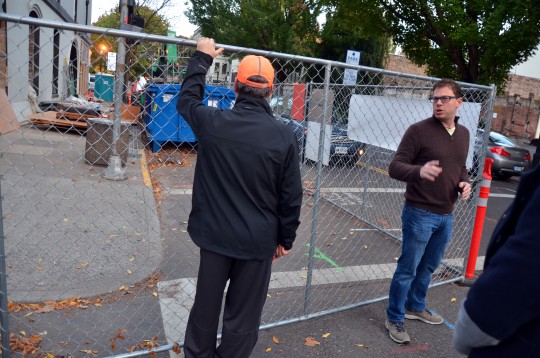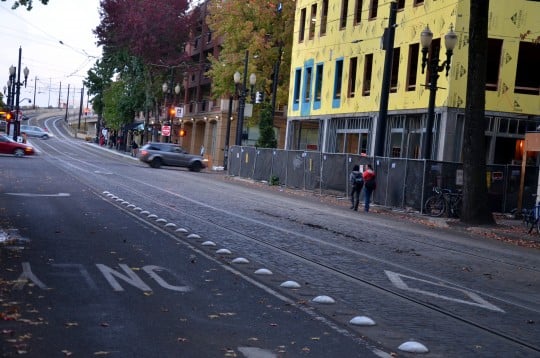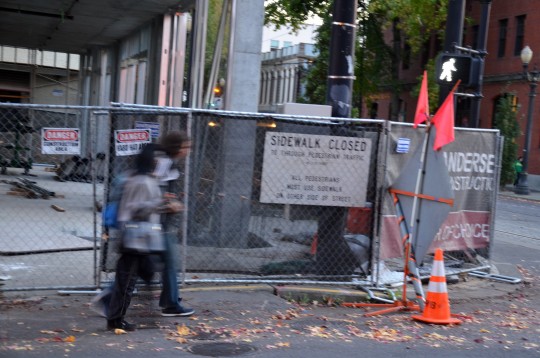
(Photos: M.Andersen/BikePortland)
Portland’s official policy is that when push comes to shove, making it safe and efficient to walk is a higher priority than making it safe and efficient to bike, which is a higher priority than making it safe and efficient to drive.
So why is it that when construction closes part of a street, sidewalks are so often the first to go?
On Thursday, a local engineering consultant led a walk through downtown Portland to show that it doesn’t have to work this way.
The walk (part of Walktober, the annual festival of fun on foot by Oregon Walks) was led by Brian Davis of Lancaster Engineering. Earlier on Thursday, Davis laid out his argument in a midday tweetstorm:
IMHO, sidewalk closures strike a nerve because they epitomize the gap between rhetoric and action that has stagnated PDX's transpo progress.
— Brian Davis (@briandavispdx) October 22, 2015
This is so, so easy to fix, too. You simply don't allow developers option to close them. That's Seattle's tack: https://t.co/HQpzQ3olQG
— Brian Davis (@briandavispdx) October 22, 2015
And if we're serious about Vision Zero (spoiler: we're not), this is an urgency. So, so many safety issues arise from sidewalk closures.
— Brian Davis (@briandavispdx) October 22, 2015
Our city is in the midst of a building boom rn, So sidewalk closures are everywhere. What was once a minor annoyance is now a big problem.
— Brian Davis (@briandavispdx) October 22, 2015
Sidewalk closures fragment the walking network, thereby making walking MUCH more difficult, especially people w/ mobility limitations.
— Brian Davis (@briandavispdx) October 22, 2015
Compare this to the driving network. Look at how we react to things that fragment it. Proposed Clinton diverters are a great example.
— Brian Davis (@briandavispdx) October 22, 2015
Adding, basically, two obstacles to driving to a street which is not crucial to driving is a huge political issue. It's taking months!
— Brian Davis (@briandavispdx) October 22, 2015
Yet fragmenting the walking network is (still, in 2015, here in the future) readily approved by the City.
— Brian Davis (@briandavispdx) October 22, 2015
If Portland is serious about progressive transportation and the green hierarchy, fixing this is the lowest of the low-hanging fruits.
— Brian Davis (@briandavispdx) October 22, 2015
We're going to fix this, and we're going to start that ball rolling tonight. Hope to see you later!
— Brian Davis (@briandavispdx) October 22, 2015
Advertisement
When we gathered Thursday evening, Davis was joined by a pair of volunteers for Oregon Walks who’ve been working with the organization (and with the Bicycle Transportation Alliance, which has been trying for years to make inroads on this issue) to convince the city to adopt a single, clear policy for what builders need to do when their project spills onto a sidewalk or roadway.
Our first stop was this year-long project on SW Stark and 3rd, where a construction project has taken over not only the sidewalk but a right-turn lane. This has removed the mixing zone that’s supposed to give people driving a chance to cross over the green bike lane without risking a collision by suddenly turning right in front of a bike at the corner.
People on foot, meanwhile, have to wait through two extra 24-second light cycles to walk down Stark. Davis said that though a sidewalk on only one side of the street is tolerable in downtown Portland because most streets are narrow and most corners have safe crossings, he thinks it’d be unreasonable on a larger street that lacks marked crosswalks.
In the case of this street, Davis said, it’d be easy to preserve mobility on Stark Street by removing the one block of auto parking during the project. Davis estimated that this would cost the city about $200 per day in lost revenue, which could simply be charged to the developer. (If the developer didn’t want to cover that cost, it might tell its builder to find a more space-efficient way to store its trucks.)
From there, we walked to 2nd and Pine, where a project had removed a general travel lane set up the sort of temporary barrier-protected sidewalk that’s common in some other cities. Because traffic is so light on this part of 2nd despite many lanes of traffic, Davis said it didn’t cause any auto congestion issues.
Further north on 1st and Couch, a closed sidewalk pushes many people into the narrow space between the MAX train tracks and curb.
Davis chose the downtown route because there were so many examples within walking distance. But this obviously isn’t a downtown problem only, and indeed it’s probably a bigger burden and greater danger in other parts of town.
Can anything be done? We talked about the fact that Portland has empowered many different agencies to issue permits for construction work that blocks roads, but given clear and consistent instructions to none of them. That means the solution is basically a matter of bureaucracy.
Oregon Walks Executive Director Noel Mickelberry said that if anyone is interested in helping advocate for the same sort of changes to Portland’s rules that Seattle just announced — that sidewalks should only be closed for construction as a last resort after other lanes have been temorarily removed — they should email her: noel@oregonwalks.org.
— Michael Andersen, (503) 333-7824 – michael@bikeportland.org







